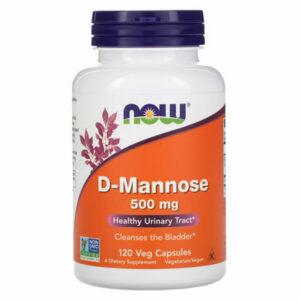D-Mannose is a popular health ingredient related to urinary tract infection alongside cranberry and probiotics.
Do you know the benefits of D-mannose? Are there any side effect?
Table of Contents
- What is D-mannose?
- What are the benefits of D-mannose?
- How to eat D-mannose?
- Are there any side effects of D-mannose?
- Safety precautions
- Where to buy the most recommended D-mannose brand?
What is D-mannose?
D-mannose is a simple sugar related to glucose. It is involved in many metabolic processes, especially in the glycosylation of certain proteins, and plays an important role in many tissues and organs.
It exists in animals, plants, and microorganisms in nature. Some fruits and vegetables contain small amounts of D-mannose, including cranberries, apples, oranges, peaches, broccoli, green beans.
What are the benefits of D-mannose?
1. D-mannose relieves urinary tract infections
Urinary tract infection is a general term that describes any infection involving any part of the urinary tract, such as kidney, ureter, bladder, and urethra.
Adult women are 30 times more likely to have urinary tract infections than men (the annual incidence rate is 10.8%), and 60% of women have at least one episode in their lifetime.
Related risk factors include sexual activity, use of catheters or spermicides, and history of recurrence of urinary tract infections.
A preliminary study (6 months, for 45 women with acute uncomplicated cystitis between the ages of 18 and 65) pointed out that oral D-mannose significantly improved most symptoms compared to the baseline score (Eg: difficulty urinating, frequent urination, urinary urgency, pubic pain, tenesmus, nocturia) and quality of life.
In addition, the recurrence rates of the D-mannose-treated group and the untreated group were 4.5% and 33.3%, respectively.
The possible mechanism behind it is related to the inhibition of bacterial adhesion to urine epithelial cells.
*Conclusion: Oral D-mannose may have a positive effect on relieving urinary tract infections, but limited to a small number of samples, more randomized controlled studies are still needed to confirm its clinical benefit.
2. D-mannose reduces the chance of recurrent urinary tract infection
Recurrent Urinary Tract Infections are defined as 3 times in the past 12 months or 2 times in 6 months, urine culture-positive urinary tract infection.
Under normal circumstances, the urinary tract is sterile, but bacteria may rise from the perianal area, pathogens in the bladder may remain silent or cause irritation symptoms such as frequent urination and urgency, and 8% of women may have asymptomatic bacteriuria.
If bacteria enter the bloodstream, they may cause serious complications, including sepsis, shock, and, in rare cases, death.
A randomized clinical trial (6 months, 308 women with a history of recurrent urinary tract infection), divided into D-mannose powder group (2 g daily), antibiotic group (Nitrofurantoin), and no preventive measures group.
It was found that the group with no preventive measures had the highest rate of recurrence of urinary tract infections (up to 60%), while both D-mannose and antibiotics significantly reduced the rate of recurrence (there were no significant differences between the two groups, 15%, and 20%, respectively).
*Conclusion: For patients with urinary tract infections who have been treated with antibiotics before, the use of D-mannose can reduce the probability of subsequent recurrent infections, but the results still need more large-scale studies to further verify.
3. D-mannose has prebiotic properties
The Food and Agriculture Organization of the United Nations currently defines prebiotic as “a food ingredient that selectively stimulates the growth or activation of one or several bacteria in the colon, thereby having a beneficial effect on the host”.
Fruits, vegetables, grains, and other edible plants are potential sources of prebiotics. Other common synthetic sources are galactose oligosaccharides, fructooligosaccharides, soybean oligosaccharides, inulin, cyclodextrin, glucose oligomers Sugar, xylose oligosaccharides, lactulose, lactulose, isomaltose oligosaccharides.
An animal study pointed out that mannose can restore the composition and number of endogenous microorganisms under the condition that the test subject’s microflora is imbalanced.
*Conclusion: D-mannose has a prebiotic effect and can help intestinal health.
4. D-mannose is beneficial for congenital glycosylation disorders
Congenital disorder of glycosylation (CDG) is a type of genetic disease characterized by defects in protein and lipid glycosylation. The most common subtype is PMM2-CDG. Since its description in 1980, it has accounted for approximately 80% of all diagnosed patients.
The clinical phenotype of PMM2-CDG ranges from light to heavy and can affect many organs, usually involving the central nervous system. Early clinical symptoms may include abnormal fat distribution, inverted nipple, strabismus, axial hypotonia, and hyporeflexia.
In addition to severe intellectual disability and other neurological abnormalities, severely ill patients also develop dysplasia, bowel disease, liver dysfunction, abnormal blood coagulation, and heart and kidney damage. In the first few years of life, the mortality rate is about 20 %.
A case study (a 5-month period for a neonate with severe congenital glycosylation type Ia) pointed out that no biochemical or biochemical or biological effects were observed when IV D-mannose was injected (daily dose 0.8 g/kg) Clinical improvement.
*Conclusion: For patients with congenital glycosylation disorders, the use of intravenous D-mannose has not brought positive help, and more research is still needed to further confirm whether there is a clinical benefit.
5. D-mannose helps lose weight
Obesity is defined as abnormal or excessive fat accumulation that may be harmful to health, mainly due to poor diet and lack of physical exercise, and involves the interaction between genetics, hormones, and the environment.
In the past few decades, the prevalence of obesity has continued to rise globally, so it is considered an epidemic.
According to the World Health Organization, by 2035, 39% of people in today’s society will be affected by obesity.
An animal study (subjects were rats fed a high-fat diet) pointed out that feeding D-mannose has the effects of reducing body weight gain, reducing fat, reducing liver fatty degeneration, increasing endurance and maximum oxygen consumption, and improving glucose tolerance.
The underlying mechanism is related to regulating the host’s intestinal microbiota and promoting metabolism.
*Conclusion: Animal studies indicate that D-mannose can bring about weight loss, but human research still needs further verification.
How to eat D-mannose?
There is currently no clinically determined standard dose or frequency for urinary tract infections. The most commonly used dose is 500 to 2000 mg once or twice a day.
Depending on the quality and purity of the product and the age, weight, and overall health of the user, each person’s response to the dose is also different.
Are there any side effects of D-mannose?
For most healthy adults, D-mannose is safe at the appropriate dose, but side effects or adverse reactions that have been reported include diarrhea, loose stools, stomach pain, dizziness, loss of appetite, fatigue, and bloating, especially In the state of large doses.
Safety Precautions
1. Do not use for pregnant women and lactating women (because the relevant safety is unknown).
2. Long-term intake of excessive doses may cause kidney damage.
3. Although D-mannose may be beneficial for urinary tract infections, the current evidence is not yet sufficient. Patients with related diseases should still consult their doctors to avoid delays.
4. Since D-mannose is a form of sugar (which may stimulate insulin secretion), use it with caution in patients with diabetes or those taking hypoglycemic drugs, and monitor blood glucose regularly.
5. Do not combine with antibiotics: Pradimicin, which may affect the efficacy of the drug.
6. Patients with small intestinal bacterial overgrowth (SIBO) have a higher chance of side effects after use, please be aware.
7. Those who have been allergic to cereals or fruits, please use with caution, as they may induce allergic reactions.
Where to buy the most recommended D-mannose brand?
In recent years, food safety problems in various countries have exploded, and it is not healthy but black-hearted products that everyone spends on. Therefore, European and American products with relatively strict quality control have become popular products.
And iHerb.com is a large-scale medical cosmetics e-commerce company in the United States. It has a high satisfaction rate of 97% in the evaluation of Google customers. It provides global home delivery so that you can buy it without risking buying fakes through purchasing high-quality health products.

